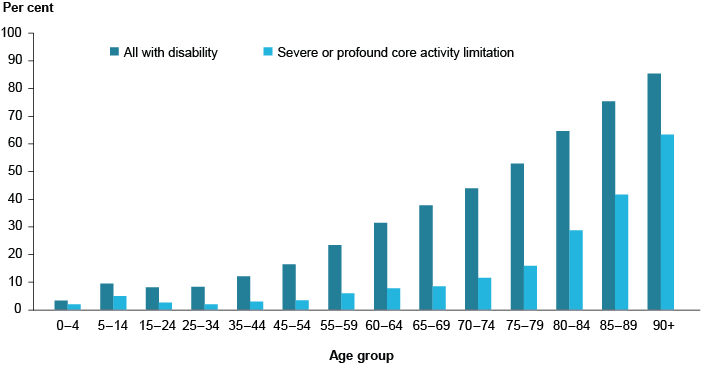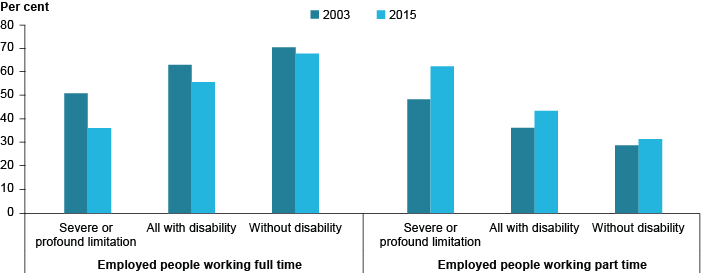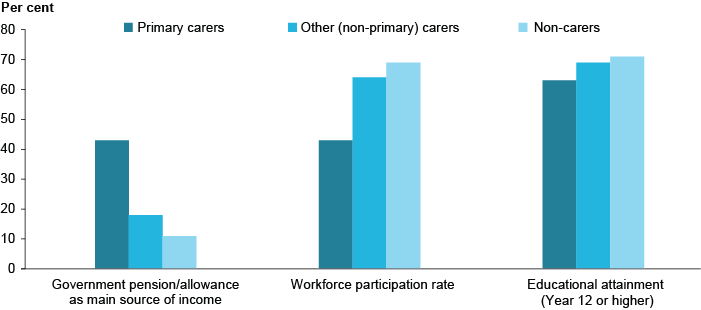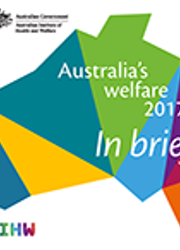Disability and carers
Some Australians face disadvantages that affect not only their physical and mental health, but also their participation in education, employment and social activities.
The World Health Organization estimates that 15% of the world's population (1 billion people) have a disability.
In 2015, 4.3 million Australians had a disability. That is:
- 1 in 5 people
The proportion of the population with disability has declined over time:
- 20% in 2003
- 18% in 2015
We are living longer without disability: years of life lived without disability in 2015 had increased since 2003, by 3.9 years for males (to 63.0 years), and by 3 years for females (to 65.2 years).
The likelihood of having a disability is similar for males and females. However, females are more likely than males to have a severe or profound core activity limitation—6.4% of females and 5.3% of males.
Four in 5 people with disability had a physical condition as their main long-term health condition; the remainder had a mental or behavioural disorder.
1.4 million with severe or profound disability
In 2015, 1 in 3 people with disability (5.8% of the total population) had severe or profound core activity limitation. This means that they sometimes or always needed help with day-to-day activities.
Disability rates increase steadily with age, ranging from 3% for children aged 0-4 to 85% for people aged 90 and over. By age 60, nearly 1 in 3 people (32%) report a disability; this rises to over 1 in 2 (53%) by age 75. A similar pattern is seen for people with severe or profound core activity limitation.
Proportion of the population with disability and severe or profound core activity limitation, by age group, 2015

Find out more: Chapter 8.1 ‘People with disability’ in Australia’s welfare 2017.
Participation in work—a greater challenge for people with disability
While people with disability participate actively in all aspects of Australian life, they can face additional challenges doing so—any disability may limit the activities a person undertakes in their daily life.
In particular, people with disability have lower rates of labour force participation and employment, and higher rates of unemployment than people without disability—even more so for people with severe or profound core activity limitation. For example 22% of people with severe or profound core activity limitation were employed in 2015 (compared with 48% of all people with disability and 79% of people without disability).
Between 2003 and 2015, there has been a shift in the patterns of work for people with disability, with fewer employed people with disability working full time and more working part time. While this shift has also been seen among employed people without disability, it has been more pronounced for people with disability—especially people with severe or profound core activity limitation.
People aged 15-64 with disability living in households who were employed, by employment type and selected disability status and severity, 2003 and 2015

Find out more: Chapter 8.2 'Participation in society by people with disability' in Australia's welfare 2017.
More than 1 in 9 of us are informal carers
Informal carers play a substantial role in assisting people who need help in their daily lives. They provided an estimated 1.9 billion hours of unpaid care in 2015.
One in 9 (2.7 million) Australians were informal carers for people in need of assistance or support due to disability, health conditions or ageing in 2015. Nearly 1 in 3 (32%) of these were primary carers.
While aspects of caring can be enjoyable and rewarding, informal carers may experience social isolation, physical and emotional strain and restricted education and employment opportunities. Primary carers, as the main caregivers, often experience these challenges most. They are more likely than other carers and non-carers to rely on government pensions and allowances and less likely to have finished Year 12 or to be in the labour force.
Income, employment and education levels for primary carers, other (non-primary) carers and non-carers, 2015

Find out more: Chapter 8.3 ‘Informal carers’ in Australia’s welfare 2017.



